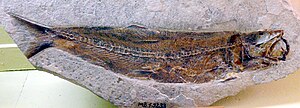Leptolepidae
| Leptolepidae | ||||||||||||
|---|---|---|---|---|---|---|---|---|---|---|---|---|

Leptolepis dubia |
||||||||||||
| Temporal occurrence | ||||||||||||
| Toarcium (Lower Jurassic) to Aptium (Lower Cretaceous) | ||||||||||||
| 182.7 to 112.9 million years | ||||||||||||
| Locations | ||||||||||||
|
||||||||||||
| Systematics | ||||||||||||
|
||||||||||||
| Scientific name of the order | ||||||||||||
| Leptolepiformes | ||||||||||||
| Goodrich , 1930 | ||||||||||||
| Scientific name of the family | ||||||||||||
| Leptolepidae | ||||||||||||
| Nicholson & Lydekker , 1889 |
The Leptolepidae are an extinct family of small, often finger-length, herring-like, probably marine bony fish , which occurred worldwide from the Lower Jurassic to the Lower Cretaceous .
features
Leptolepidae species were the first real bony fish whose spine was already well ossified. The vertebrae had only one central perforation, which became smaller and smaller in the course of evolution. The caudal fin was externally homocerous , but the end of the spine was curved upwards and corresponded to that of the female fish ( Elops ). Their bone cells resembled those of most herring-like species (Clupeiformes). The sensory channels correspond to those of the Palaeoniscidae . There was a transverse sensory channel on the muzzle.
Leptolepidae species had a thin layer of ganoin on the cover bones of the skull. The thin, brick-like overlapping cycloid scales also had a fine layer of ganoin on their outer surface. The paired parietal bone had a short contact surface. The lower jaw consisted of articular and dental . The maxillary margin is formed by the maxillary and small premaxillary .
Genera
literature
- Arno Hermann Müller: Textbook of paleozoology. Volume III, Vertebrates, Part 1. Gustav Fischer Verlag, 1985